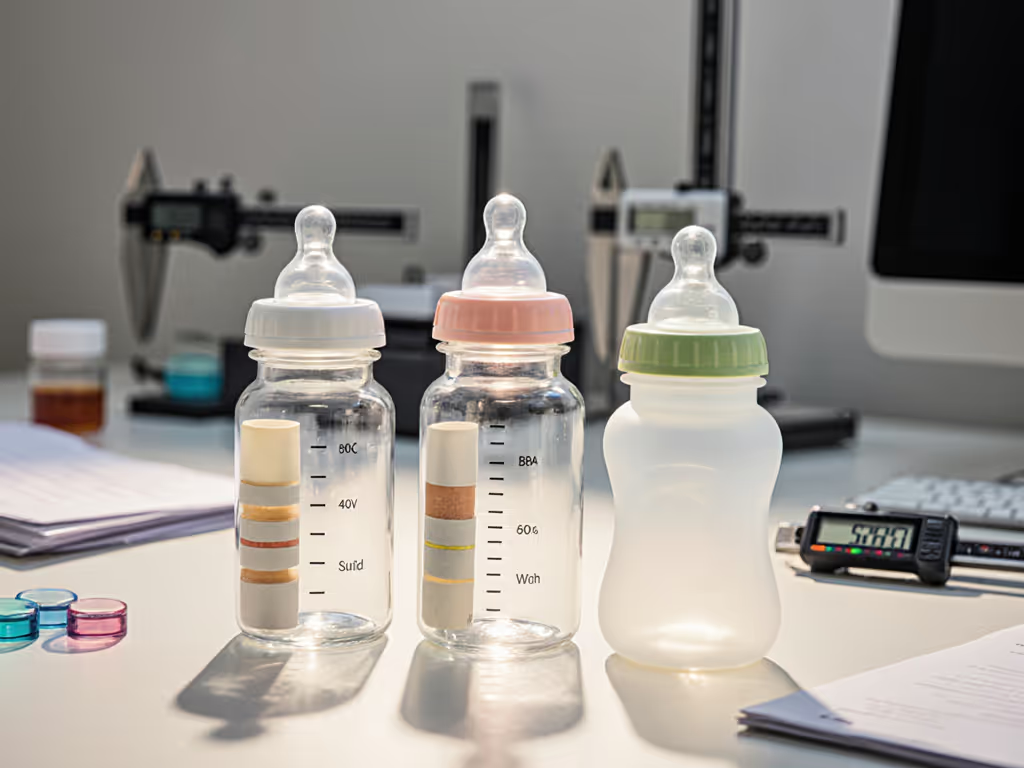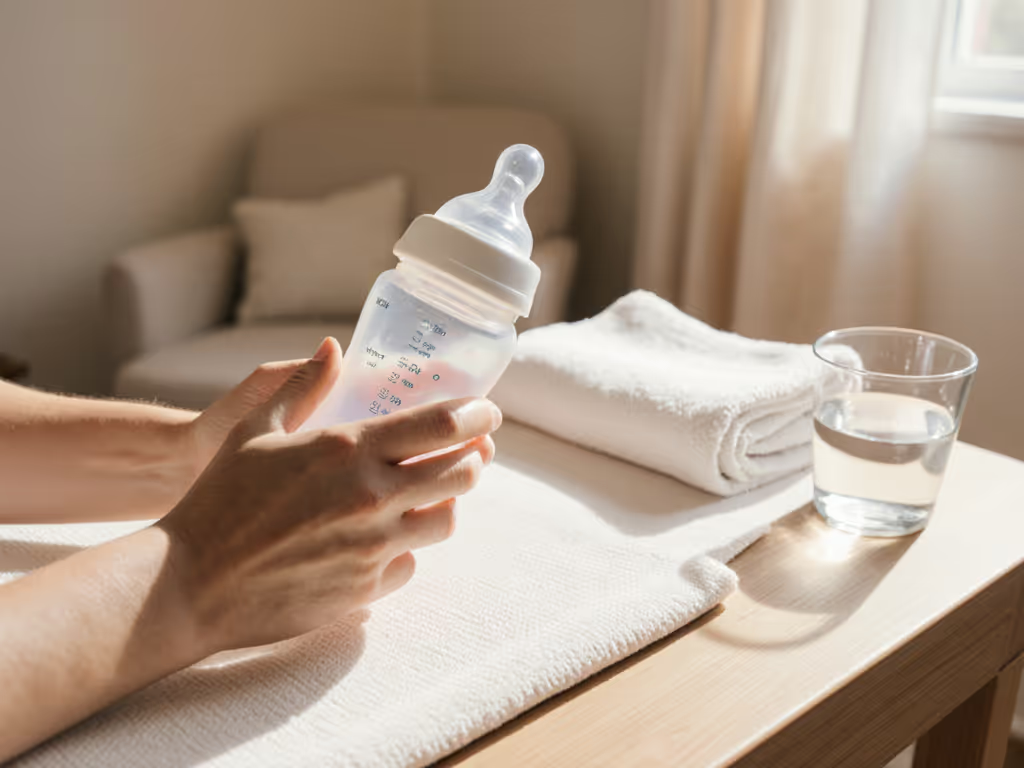
Complete Guide to the Role of Bottle Construction

Selecting a baby bottle might seem simple until you realize how much rides on its design. Studies show that improper bottle construction can increase feeding difficulties and even health risks for infants. Every choice from the material to the nipple shape directly affects your baby’s comfort and nutrition. Understanding the essentials of bottle construction helps parents make safer decisions, blending technology and thoughtful design to support healthier, happier feeding moments.
Key Takeaways
| Point | Details |
|---|---|
| Material Safety Matters | Ensure bottles are made from safe, medical-grade materials to prevent chemical leaching and support infant health. |
| Nipple Design is Crucial | Opt for nipples that mimic breastfeeding to ease transitions and support natural feeding patterns for infants. |
| Hygiene is Paramount | Follow rigorous cleaning protocols and regularly inspect bottles to prevent bacterial contamination and ensure infant safety. |
| Address Common Mistakes | Avoid using damaged bottles, inappropriate nipple flow rates, and ensure proper cleaning to reduce feeding-related health risks. |
Defining Bottle Construction in Baby Feeding
Bottle construction represents the critical design process of creating feeding vessels that safely and effectively support infant nutrition. At its core, bottle construction involves intricate engineering that considers multiple factors: material safety, shape, nipple design, and functional performance to match an infant's unique feeding requirements.
The fundamental components of bottle construction include the bottle body, nipple, collar, and cap. Each element plays a significant role in creating a safe feeding experience. Bottle bodies are typically manufactured from materials like medical-grade polypropylene, glass, or specialized food-safe plastics designed to withstand sterilization processes and prevent chemical leaching. The shape and design aim to facilitate easy cleaning, comfortable grip for caregivers, and optimal milk flow for infants.
Nipple design represents another crucial aspect of bottle construction. Drawing from pediatric research, nipple construction mimics natural breastfeeding mechanics. According to research from PubMed, healthy infants utilize similar tongue and jaw movements during bottle feeding, creating suction through precise teat compression. Modern nipple designs incorporate features like graduated flow rates, anti-colic vents, and soft, flexible materials that respond to an infant's natural sucking patterns.
Key considerations in bottle construction include:
- Material safety and chemical stability
- Ease of cleaning and sterilization
- Compatibility with infant feeding reflexes
- Reduction of air intake during feeding
- Durability and long-term performance
The CDC emphasizes that regardless of construction complexity, maintaining impeccable hygiene remains paramount. Proper cleaning, sterilization, and careful handling are essential to prevent potential germ contamination and ensure infant health and safety during every feeding session.
Materials and Design Variations Explained
Bottle materials represent a critical foundation in infant feeding technology, offering diverse options that balance safety, performance, and practicality. Modern bottle construction has evolved beyond simple containers, incorporating advanced materials science to create feeding solutions that adapt to infants' complex nutritional needs.
Traditional bottle materials include glass, plastic, silicone, and stainless steel, each presenting unique characteristics. Glass bottles offer exceptional heat resistance and chemical inertness but are heavier and more fragile. Plastic variants like medical-grade polypropylene provide lightweight durability and are often preferred for their impact resistance and affordability. Specialized plastics undergo rigorous testing to ensure they remain free from harmful chemicals like BPA, phthalates, and other potentially toxic substances.
Design variations extend far beyond material selection, focusing on nuanced features that enhance feeding efficiency. Venting systems represent a significant innovation, designed to reduce air intake and minimize common issues like colic and gas. Some advanced bottle designs incorporate sophisticated anti-colic mechanisms that create small channels or specialized valves, allowing air to escape and preventing vacuum formation during feeding. These engineering approaches mimic natural breastfeeding patterns, helping infants maintain comfortable feeding rhythms.
Key material and design considerations include:
- Chemical safety and stability
- Weight and ergonomic handling
- Impact resistance
- Temperature tolerance
- Ease of cleaning and sterilization
Manufacturers like Smilo highlight the importance of material selection, emphasizing how polyamide and polypropylene offer optimal combinations of lightweight structure, stability, and medical-grade safety.
![]() By integrating medical-grade silicone nipples with carefully engineered bottle bodies, modern designs create comprehensive feeding solutions that prioritize infant comfort and nutritional delivery.
By integrating medical-grade silicone nipples with carefully engineered bottle bodies, modern designs create comprehensive feeding solutions that prioritize infant comfort and nutritional delivery.

Key Components: Nipples, Vents, and Liners
Bottle components are sophisticated engineering solutions designed to support infant feeding dynamics, with each element playing a critical role in nutrition delivery and comfort. The intricate interaction between nipples, vents, and liners determines the overall effectiveness of a baby bottle, transforming simple feeding into a carefully orchestrated nutritional experience.
Nipple design stands at the forefront of bottle technology, representing the primary interface between infant and nutrition. Medical-grade silicone nipples are crafted to mimic natural breastfeeding mechanics, featuring carefully graduated flow rates that adapt to an infant's sucking strength. Different nipple shapes and sizes accommodate various infant ages and feeding preferences, with some designs incorporating soft, responsive materials that flex and compress similarly to human breast tissue. Advanced nipple constructions include multiple flow rates - from slow for newborns to faster versions for older infants - ensuring age-appropriate milk delivery.
Venting systems represent a revolutionary approach to addressing common feeding challenges. Research from BMC Research Notes demonstrates that internal venting mechanisms can significantly reduce infant distress by preventing air intake during feeding. These sophisticated designs create controlled air channels that eliminate vacuum formation, minimizing issues like colic, gas, and discomfort. Some advanced venting technologies use intricate valve systems or specialized nipple designs that allow continuous, measured air replacement during milk consumption.
Key bottle component considerations include:
- Nipple material flexibility
- Flow rate adaptability
- Air elimination efficiency
- Compatibility with different milk types
- Ease of cleaning and sterilization
Liner technologies provide an additional layer of hygiene and convenience, offering disposable inner bags that minimize bacterial contamination and simplify cleaning processes. By creating a protective barrier between milk and bottle surface, liners help maintain nutritional integrity and reduce potential contamination risks. Modern liner designs are typically made from thin, medical-grade plastics that are pre-sterilized and designed for single-use applications, providing parents with an extra safeguard in infant feeding protocols.
How Construction Impacts Feeding Experience
Bottle construction fundamentally transforms the infant feeding process, acting as a critical bridge between nutrition delivery and infant comfort. Each design element directly influences the physiological and emotional experience of feeding, turning what might seem like a simple act into a complex interaction of engineering and infant physiology.
Research from PubMed reveals that sophisticated bottle designs can remarkably mimic natural breastfeeding mechanics, supporting infants' intrinsic feeding patterns. Mechanical engineering in bottle construction plays a pivotal role in recreating the dynamic pressure and flow characteristics experienced during breastfeeding. Innovative designs incorporate subtle features like variable nipple elasticity, graduated flow rates, and strategic venting systems that help infants maintain consistent sucking rhythms similar to those observed in direct breastfeeding.
The psychological and physical impact of bottle construction extends beyond mere nutrition delivery. Feeding experience is significantly shaped by how well a bottle's design reduces potential stressors like air intake, nipple confusion, and feeding fatigue. Studies from BMC Research Notes demonstrate that bottles with advanced anti-vacuum mechanisms can dramatically reduce infant distress, leading to more relaxed and efficient feeding sessions. These nuanced design considerations address critical challenges such as colic, gas accumulation, and feeding-related discomfort.
Key impacts of bottle construction on feeding experience include:
- Reduction of feeding-related stress
- Mimicking natural breastfeeding mechanics
- Minimizing air intake and digestive discomfort
- Supporting consistent feeding rhythms
- Adapting to infant's developmental stages
Ultimately, thoughtful bottle construction represents more than technical design—it's a holistic approach to supporting infant nutrition, comfort, and developmental well-being. By understanding and implementing sophisticated engineering principles, manufacturers can create feeding solutions that not only deliver nutrition but also promote positive, nurturing feeding experiences for both infants and caregivers.
Risks, Safety Concerns, and Common Mistakes
Bottle safety represents a critical dimension of infant nutrition, where seemingly minor oversights can lead to significant health risks. Understanding the potential dangers and proactively addressing them becomes paramount in creating a safe feeding environment that protects an infant's delicate developmental ecosystem.
Nipple confusion emerges as a primary concern in bottle feeding, a complex physiological challenge where infants struggle to transition between breast and bottle feeding mechanisms. Research indicates that introducing bottles too early can disrupt natural breastfeeding patterns, potentially causing feeding refusal and nutritional challenges. The CDC recommends delaying bottle introduction during the initial weeks after birth to establish consistent breastfeeding routines and minimize potential developmental interruptions. Careful nipple selection, focusing on designs that mimic natural breast tissue and flow, can help mitigate these transitional difficulties.
Contamination risks represent another significant safety concern in bottle construction and usage. Bacterial growth can rapidly proliferate in improperly cleaned or stored feeding equipment, potentially exposing infants to harmful pathogens. The CDC emphasizes rigorous cleaning protocols, recommending thorough washing of all feeding supplies with hot, soapy water and complete sterilization, particularly for premature infants or those with compromised immune systems. Advanced bottle designs now incorporate materials and shapes that facilitate easier cleaning and faster drying, reducing potential bacterial harboring zones.
Common bottle feeding mistakes to avoid include:
- Using bottles beyond recommended replacement timelines
- Inconsistent or inadequate cleaning procedures
- Selecting inappropriate nipple flow rates
- Adding solid foods to bottles
- Ignoring signs of nipple wear or damage
Additional safety considerations involve monitoring bottle materials for potential chemical leaching, ensuring temperature-appropriate milk storage, and recognizing individual infant feeding responses. Parents must remain vigilant, regularly inspecting bottles for micro-cracks, discoloration, or structural compromises that could introduce potential contamination risks. By combining informed product selection with meticulous maintenance practices, caregivers can significantly reduce potential feeding-related health complications.
Enhance Your Baby's Feeding Experience with Expert Bottle Guidance
Understanding the complexities of bottle construction is essential to solving common feeding issues like nipple confusion, gas, and feeding refusal. This article highlights critical pain points such as the need for precise nipple flow rates, effective venting systems, and safe materials that mimic natural breastfeeding mechanics. Parents often feel overwhelmed trying to balance all these elements while ensuring their baby feeds comfortably and safely.
At Family Bottle Fit, we specialize in guiding parents through selecting and customizing baby bottles tailored to their infant’s unique needs. Our carefully researched resources help you avoid common mistakes and confidently match bottle components—including nipples, vents, and materials—to your baby's feeding style. Don't let feeding challenges add stress to your routine. Visit Family Bottle Fit now and discover practical tips and tools designed specifically to promote calmer and more effective feeding sessions. Start transforming your baby's feeding experience today and give your little one the comfort they deserve.
Frequently Asked Questions
What are the main components of baby bottle construction?
The main components of baby bottles include the bottle body, nipple, collar, and cap, each designed to ensure a safe and effective feeding experience.
How does nipple design impact infant feeding?
Nipple design is crucial as it mimics natural breastfeeding mechanics, featuring graduated flow rates and flexible materials to support an infant's sucking patterns and comfort during feeding.
What are the risks associated with improper bottle feeding?
Improper bottle feeding can lead to risks such as nipple confusion and bacterial contamination, which can affect an infant's ability to feed properly and lead to health complications.
What materials are commonly used in baby bottle construction and why?
Common materials include glass, medical-grade polypropylene, silicone, and stainless steel. These materials are selected for their safety, durability, ease of cleaning, and resistance to chemical leaching.
Recommended
Related Articles


Why Slow Flow Nipples Matter: Complete Guide

Step-by-Step Guide to Preventing Nipple Confusion Easily

Step-by-Step Guide to Anti Colic Bottles for Parents

